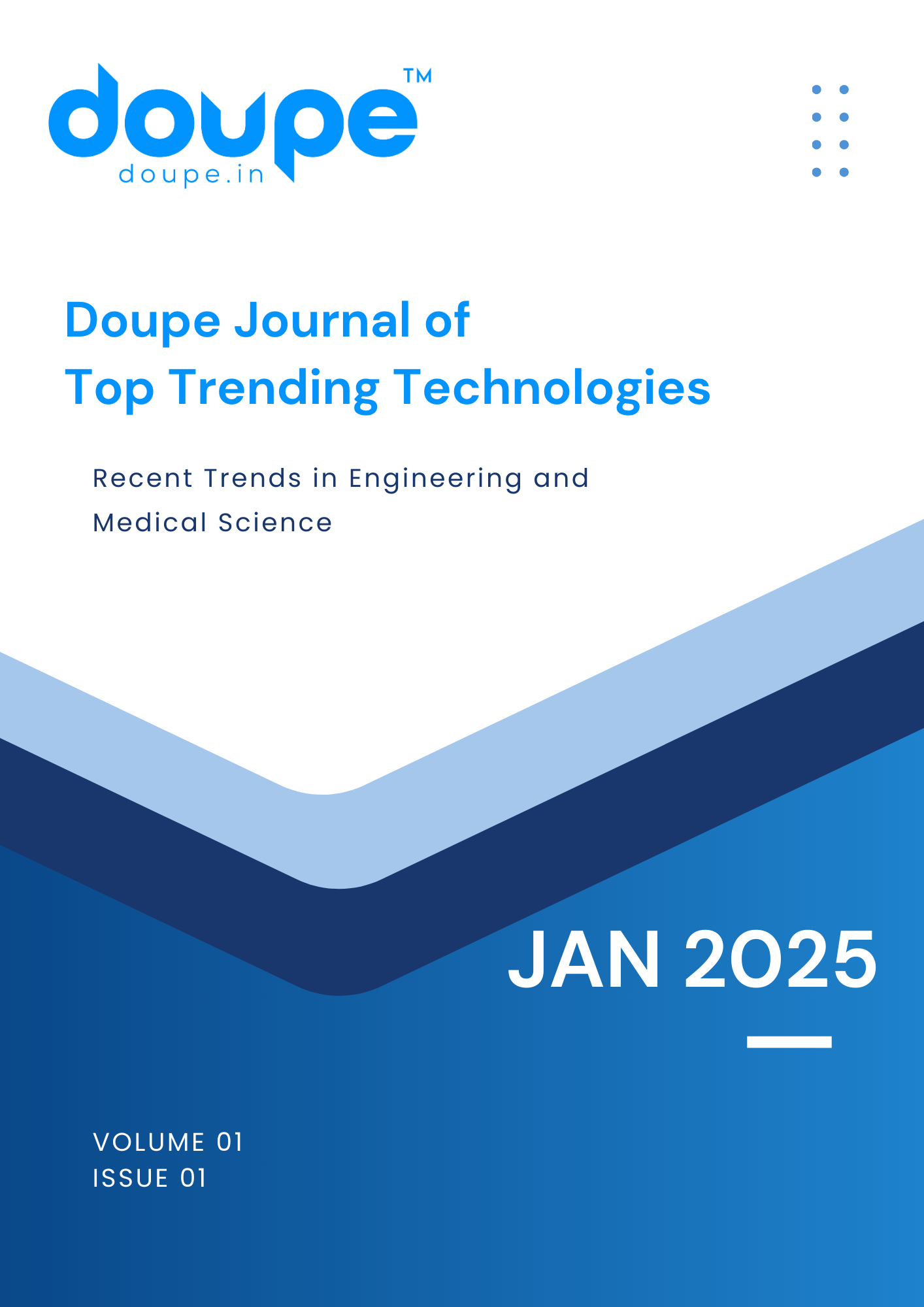Artificial Intelligence Models for Detecting Heart Failures in Patients
Main Article Content
Abstract
In the field of healthcare the use of AI in diagnosing heart failure and supporting the treatment plans for patients has been highlighted to be very useful. Hence, based on the literature, this paper seeks to examine how AI has been relevant in this area and also the challenges and new breakthroughs that were made when implementing it. Guided by the explanation of the newest tendencies and trends worth noting in this sphere, this paper aims to explain the efficiency of AI models of heart failures and the impact of the enhanced identification of such failures to improve the methods of treatment and the outcomes for the patients. Thus, the paper further contributes to the already existing body of literature available on the application of AI in the field of cardiology and the likely shift that the application of this technology might bring in the way diagnostic strategies are approached.
Downloads
Article Details
Accepted 2024-09-26
Published 2024-12-22
References
Yoon M, Park JJ, Hur T, Hua CH, Hussain M, Lee S, Choi DJ. Application and Potential of Artificial Intelligence in Heart Failure: Past, Present, and Future. Int J Heart Fail. 2024 Jan;6(1):11-19. https://doi.org/10.36628/ijhf.2023.0050
Choi, DJ., Park, J.J., Ali, T. et al. Artificial intelligence for the diagnosis of heart failure. npj Digit. Med. 3, 54 (2020). https://doi.org/10.1038/s41746-020-0261-3
F. Yasmin et al. “Artificial intelligence in the diagnosis and detection of heart failure: the past, present, and future”. In: Reviews in Cardiovascular Medicine 22.4 (2021), p. 1095. :https://doi.org/10.31083/j.rcm2204121.
A. A. Armoundas et al. “Use of Artificial Intelligence in Improving Outcomes in Heart Disease A Scientific Statement From the American Heart Association”. In: Circulation (2024). :https://doi.org/10.1161/cir.0000000000001201.
V. Chang and A. Hossain et al. “An artificial intelligence model for heart disease detection using machine learning algorithms”. In: Healthcare Analytics 2 (2022), p. 100016. :https://doi.org/10.1016/j.health.2022.100016.
M. S. Khan et al. “Artificial intelligence and heart failure: A state-of-the-art review”. In: European Journal of Heart Failure 25.9 (2023), pp. 1507–1525. :https://doi.org/10.1002/ejhf.2994.
T. Averbuch et al. “Applications of artificial intelligence and machine learn- ing in heart failure”.In: European Heart Journal - Digital Health 3 (2022), pp. 311–322. :https://doi.org/10.1093/ehjdh/ztac025.
K. Erdem and Murat Koklu et al. “A Detailed Analysis of Detecting Heart Diseases Using Artificial Intelligence Methods”. In: Intelligent methods in engineering sciences (2023). :https://doi.org/10.58190/imiens.2023.71.
I. U. Haq and B. Xu et al. “Artificial Intelligence in Cardiovas- cular Medicine: Current Insights and Future Prospects”. In: Vascular Health and Risk Management 18 (2022), pp. 517–528. :https://doi.org/10.2147/VHRM.S279337.
K. Seetharam et al. “Applications of Machine Learning in Cardiology”. In: Cardiology and Therapy 11.3 (2022), pp. 355–368. :https://doi.org/10.1007/s40119-022-00273-7.
R. Cuocolo and M. Petretta et al. “Current applications of big data and machine learning in cardiology”. In: Journal of Geriatric Cardiology : JGC 16.8 (2019), pp. 601–607.
H. Y. Mir and O. Singh. “ECG denoising and feature extraction techniques – a review”. In: Journal of Medical Engineering and Technology 45.8 (2021), pp. 672–684. :https://doi.org/10.1080/03091902.2021.1955032.
S. Kuila and S. Joardar et al. “Feature extraction of electrocardiogram signal using machine learning classification”. In: International Journal of Electrical and Computer Engineering (IJECE) 10.6(2020), p. 6598. :https://doi.org/10.11591/ijece.v10i6.pp6598-6605.
C. Martin-Isla et al. “Image-Based Cardiac Diagnosis With Machine Learning: A Review”. In:Frontiers in Cardiovascular Medicine 7 (2020). :https://doi.org/10.3389/fcvm.2020.00001.
R. G. Barriada and D. Masip. “An Overview of Deep-Learning-Based Methods for Cardiovascular Risk Assessment with Retinal Images”. In: 13.1 (2022), p. 68. :https://doi.org/10.3390/diagnostics13010068.
A. Bleich and T. O. F. Conrad et al. “Enhancing Electrocardiogram (ECG) Analysis of Implantable Cardiac Monitor Data: An Efficient Pipeline for Multi-Label Classification”. In: Machine Learning and Knowledge Extraction 5.4 (2023), pp. 1539–1556. :https://doi.org/10.3390/make5040077.
Y.-X. Guan and J.-X. Wang et al. “Intelligent Electrocardiogram Analysis in Medicine: Data,Methods, and Applications”. In: Chinese Medical Sciences Journal 38.1 (2023), pp. 38–48. :https://doi.org/10.24920/004160.
T. Zhou et al. “Multimodal data integration for enhanced longitudinal prediction for cardiac and cerebrovascular events following initial diagnosis of obstructive sleep apnea syndrome”. In: Journal of Global Health 14.2 (2024), p. 0413. :https://doi.org/10.7189/jgh.14.04103.
R.Wali et al. “Integrated machine learning and multimodal data fusion for patho-phenotypic feature recognition in iPSC models of dilated cardiomyopathy”. In: Biological Chemistry (2024). :https://doi.org/10.1515/hsz-2024-0023.
Y. Lu and H. M. Krumholz et al. “Clinical decision support in cardiovascular medicine,” BMJ”. In:(2022). :https://doi.org/10.1136/bmj-2020-059818.
R. Sutton and D. Pincock. “An overview of clinical decision support systems: benefits, risks and strategies for success”. In: NPJ Digital Medicine 3.1 (2020), pp. 1–10. :https://doi.org/10.1038/s41746-020-0221-y.
S. J. Rao et al. “An Update on the Use of Artificial Intelligence in Cardiovascular Medicine”. In:Hearts 5.1 (2024), pp. 91–104. :https://doi.org/10.3390/hearts5010007.
X. Sun and T. L. Huo et al. “Artificial intelligence in cardiovascular diseases: diagnostic and therapeutic perspectives”. In: European Journal of Medical Research 28.1 (2023). :https://doi.org/10.1186/s40001-023-01065-y.
A. Bourazana et al. “Artificial Intelligence in Heart Failure: Friend or Foe?” In: Life 14.1 (2024),p. 145. :https://doi.org/10.3390/life14010145.
S. Abbas et al. “Artificial intelligence framework for heart disease classification from audio signals”.In: Scientific Reports 14.1 (2024), p. 3123. :https://doi.org/10.1038/s41598-024-53778-7.
J.-D. Huang and J. Condell et al. “Applying Artificial Intelligence to Wearable Sensor Data to Diagnose and Predict Cardiovascular Disease: A Review”. In: Sensors 22.20 (2022), p. 8002. :https://doi.org/10.3390/s22208002.
Buhari Ugbede Umar and M.Atama et al. “Artificial intelligence model for prediction of cardiovasculardisease: An empirical study”. In: Deleted Journal 1.1 (2023), pp. 1746–1746. :https://doi.org/10.36922/aih.1746.
